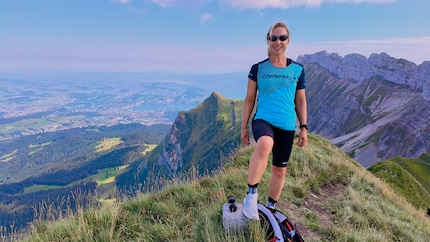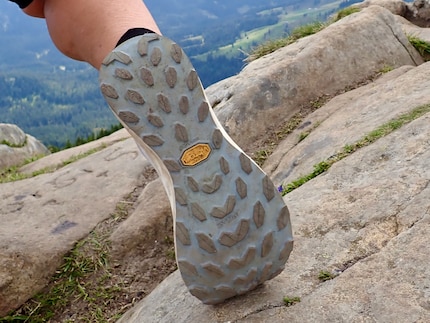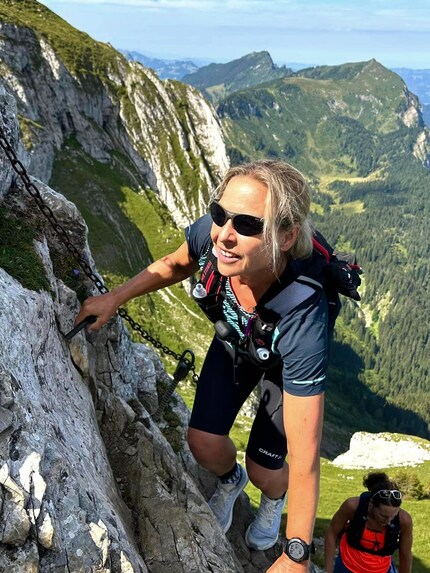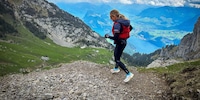
Product test
10 weeks until my half marathon – will I be running in Nnormal shoes?
by Siri Schubert

Operation: get out of my routine. Running in the mountains adds a touch of fun and variety. So I halted my training for a half marathon and instead went on a trail running workshop. I discovered you can get really good kit for it.
Over the last few weeks, I’ve been preparing for the Hallwilersee half marathon taking place in mid October. I like running round the lake, but it’s even nicer when the trail goes into the mountains. Getting to experience nature, the views, the technical and physical challenges – all of it fascinates me. And if I can run alongside Up2Peak coaches and an enthusiastic group, the day is already perfect.
I had to cover almost 18 km and 1,360 m of altitude. In summer temperatures no less. We found ourselves on very different trails: from springy-soft forest paths to those with roots, to rocky paths with boulders, which turned trail running into hiking. The varied and challenging course provided ample opportunity to test out running clothes – from shoes to T-shirts. Any weaknesses in quality and function would certainly rear their head during this run.

Training for trail running was the perfect opportunity to test out the Kjerag, a shoe from the Norwegian brand Nnormal. I’d already put it through its paces on paths and forest trails. Now it was time to progress to more challenging terrain.
I did have some qualms about whether the 3.5 mm tread would be enough to let me run on unpaved paths without slipping. I was also curious to see how the midsole would manage with 23.5 mm at the heel and 17.5 mm at the forefoot. Compared with other trail running shoes, it offers relatively little cushioning. I like to feel the ground under my feet when I walk, but if the sole is too thin and the stones too sharp, it can get uncomfortable.

It turns out my doubts were unfounded. The Kjerag provides excellent grip on any surface, and running felt good from start to finish. The shoe fit perfectly while I was running both uphill and downhill, and the wide toe box prevented any blisters or pressure points. As we were out on a dry, warm summer’s day, I wasn’t able to check how well the shoe performed on wet surfaces. So for testing purposes, I also ran across wet stones at Lake Hallwil. The Vibram Megagrip sole also copes well there and lives up to its name. The Kjerag has the potential to become my go-to shoe, be it on the trails around the lake or in mountainous terrain.
Running socks? The thought occurred to me a few months ago: what should they be able to do that normal socks can’t? Until now, I’ve just picked out an older everyday pair for jogging. But after hearing over and over again that good socks prevent chafing and blisters, keep your feet nice and dry, and provide support, I decided to try proper running socks.
The Compressport Pro Racing V3.0 Trail – what a name – appealed to me because they’re designed for more than just keeping your feet dry. They’ve also been equipped with a compression band and other compression elements to improve blood flow back to the heart. What’s more, they don’t have any seams or elastic that can rub. I thought if I was going all out, I may as well order this luxury pair.
As I don’t have much experience with them, I can’t do a direct comparison with other running socks. What I can say, however, is that even on hot days, my feet stayed dry and relatively cool during an 18 km run. Whether the blood really does flow back to your heart better with short socks like these isn’t something I can really gauge. But the tight fit around the ankle definitely felt very comfortable, and the socks didn’t slip one bit.
I’ve always opted for running shorts that are short and airy. But on longer runs, they ended up rubbing and weren’t quite so pleasant. So for this run, I decided to try out the Craft Pro Control Compression Tight Shorts – another name that sounds ridiculously high-tech.
It looks a bit like I’m about to pedal my way into the Tour de France – that was my initial thought when I tried them on. They look unmistakeably like cycle shorts. That almost made me not wear them. I was worried they’d be too warm and not suitable for running. By the end of the run, I’d completely changed my mind. The shorts fit well and channel heat and moisture away from the body. They do all this without chafing, as they don’t have seams that get in the way. In fact, I didn’t feel them at all throughout the whole trail run. It wasn’t until we had an apple spritzer in the pub afterwards that I noticed they were still quite dry and comfortable.
I wasn’t really aware of the aforementioned compression either, except for the fact the shorts were tight. But maybe that’s also a good sign, because I probably wouldn’t have found it comfortable if I had too much pressure on my thighs. As it was, they just felt natural. So I’ve changed my stance on this as well. From now on, I don’t mind if running shorts look like cycle shorts as long as they’re as comfortable to wear as the Craft ones.

I haven’t had the best experience with functional polyester T-shirts in the past. Often, their only real function seemed to be to stink beyond all belief the moment I expended the slightest effort. That’s why I often opt for merino wool T-shirts for exercising. But that’s too warm for a summer run.
Dynafit’s Alpine Shirt appealed to me because, at 77 g, it’s extremely light and feels airy. I like the fact it’s made of 100% recycled PET bottles. But it was hard to believe a plastic T-shirt wouldn’t stink. Amazingly, it’s true – it doesn’t. Honestly! It passed the endurance test. After a strenuous run in the mountains, I took it off and put it in my backpack in its sweaty condition. Gross, I know. When I took it out once I got home, it didn’t smell at all. And that’s not just my impression. I had my husband’s bloodhound nose check it straight away. So, I put the T-shirt on again for another run and wore it once for cycling before washing it. I see it as a meaningful sustainability effort. Because not washing as often means less water and detergent consumption. It also usually translates into less wear and tear on the fabric and therefore fewer microplastics in the water.
The reason my T-shirt doesn’t smell is its polygiene treatment, which uses silver salts to prevent bacterial growth and therefore also odours.
I’m sure I could’ve used usual running clothes, apart from the shoes. But it does make a difference when I feel comfortable for the whole trail running workshop, and I’m neither too hot nor cold. Coming back without chafing and blisters also reinforces the positive experience. Last but not least, I like the fact I don’t need to carry my T-shirt straight from my backpack to the washing machine like some kind of stink bomb. Odour-wise, I could even have left it on in the pub for the post-run spritzer without it bothering other patrons with unpleasant whiffy wafts.
Header image: Up2Peak
Research diver, outdoor guide and SUP instructor – I love being in, on and around water. Lakes, rivers and the ocean are my playgrounds. For a change of perspective, I look at the world from above while trail running or flying drones.

Product test
by Siri Schubert

Product test
by Siri Schubert

Product test
by Siri Schubert